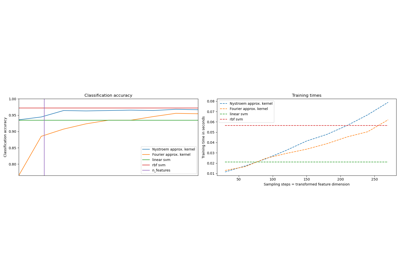sklearn.kernel_approximation.RBFSampler¶
- class sklearn.kernel_approximation.RBFSampler(*, gamma=1.0, n_components=100, random_state=None)[source]¶
Approximate a RBF kernel feature map using random Fourier features.
It implements a variant of Random Kitchen Sinks.[1]
Read more in the User Guide.
- Parameters
- gammafloat, default=1.0
Parameter of RBF kernel: exp(-gamma * x^2).
- n_componentsint, default=100
Number of Monte Carlo samples per original feature. Equals the dimensionality of the computed feature space.
- random_stateint, RandomState instance or None, default=None
Pseudo-random number generator to control the generation of the random weights and random offset when fitting the training data. Pass an int for reproducible output across multiple function calls. See Glossary.
- Attributes
- random_offset_ndarray of shape (n_components,), dtype=float64
Random offset used to compute the projection in the
n_componentsdimensions of the feature space.- random_weights_ndarray of shape (n_features, n_components), dtype=float64
Random projection directions drawn from the Fourier transform of the RBF kernel.
- n_features_in_int
Number of features seen during fit.
New in version 0.24.
- feature_names_in_ndarray of shape (
n_features_in_,) Names of features seen during fit. Defined only when
Xhas feature names that are all strings.New in version 1.0.
See also
AdditiveChi2SamplerApproximate feature map for additive chi2 kernel.
NystroemApproximate a kernel map using a subset of the training data.
PolynomialCountSketchPolynomial kernel approximation via Tensor Sketch.
SkewedChi2SamplerApproximate feature map for “skewed chi-squared” kernel.
sklearn.metrics.pairwise.kernel_metricsList of built-in kernels.
Notes
See “Random Features for Large-Scale Kernel Machines” by A. Rahimi and Benjamin Recht.
[1] “Weighted Sums of Random Kitchen Sinks: Replacing minimization with randomization in learning” by A. Rahimi and Benjamin Recht. (https://people.eecs.berkeley.edu/~brecht/papers/08.rah.rec.nips.pdf)
Examples
>>> from sklearn.kernel_approximation import RBFSampler >>> from sklearn.linear_model import SGDClassifier >>> X = [[0, 0], [1, 1], [1, 0], [0, 1]] >>> y = [0, 0, 1, 1] >>> rbf_feature = RBFSampler(gamma=1, random_state=1) >>> X_features = rbf_feature.fit_transform(X) >>> clf = SGDClassifier(max_iter=5, tol=1e-3) >>> clf.fit(X_features, y) SGDClassifier(max_iter=5) >>> clf.score(X_features, y) 1.0
Methods
fit(X[, y])Fit the model with X.
fit_transform(X[, y])Fit to data, then transform it.
get_params([deep])Get parameters for this estimator.
set_params(**params)Set the parameters of this estimator.
transform(X)Apply the approximate feature map to X.
- fit(X, y=None)[source]¶
Fit the model with X.
Samples random projection according to n_features.
- Parameters
- X{array-like, sparse matrix}, shape (n_samples, n_features)
Training data, where
n_samplesis the number of samples andn_featuresis the number of features.- yarray-like, shape (n_samples,) or (n_samples, n_outputs), default=None
Target values (None for unsupervised transformations).
- Returns
- selfobject
Returns the instance itself.
- fit_transform(X, y=None, **fit_params)[source]¶
Fit to data, then transform it.
Fits transformer to
Xandywith optional parametersfit_paramsand returns a transformed version ofX.- Parameters
- Xarray-like of shape (n_samples, n_features)
Input samples.
- yarray-like of shape (n_samples,) or (n_samples, n_outputs), default=None
Target values (None for unsupervised transformations).
- **fit_paramsdict
Additional fit parameters.
- Returns
- X_newndarray array of shape (n_samples, n_features_new)
Transformed array.
- get_params(deep=True)[source]¶
Get parameters for this estimator.
- Parameters
- deepbool, default=True
If True, will return the parameters for this estimator and contained subobjects that are estimators.
- Returns
- paramsdict
Parameter names mapped to their values.
- set_params(**params)[source]¶
Set the parameters of this estimator.
The method works on simple estimators as well as on nested objects (such as
Pipeline). The latter have parameters of the form<component>__<parameter>so that it’s possible to update each component of a nested object.- Parameters
- **paramsdict
Estimator parameters.
- Returns
- selfestimator instance
Estimator instance.
- transform(X)[source]¶
Apply the approximate feature map to X.
- Parameters
- X{array-like, sparse matrix}, shape (n_samples, n_features)
New data, where
n_samplesis the number of samples andn_featuresis the number of features.
- Returns
- X_newarray-like, shape (n_samples, n_components)
Returns the instance itself.

